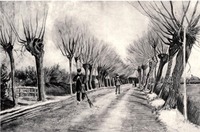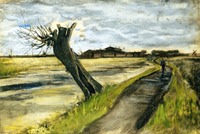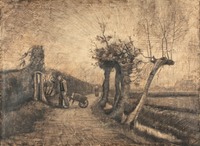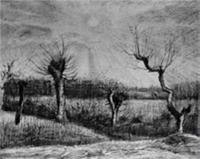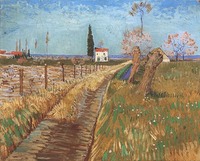vincent van gogh pollard willows with setting sun 1888
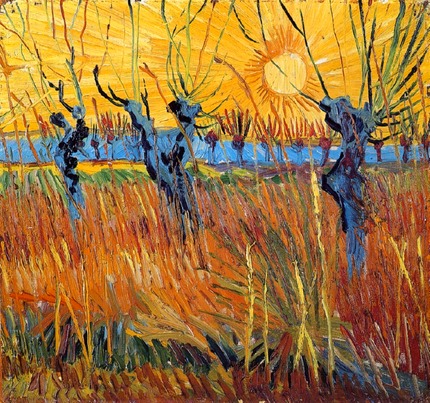
The pollard willow was one of Van Gogh's favourite subjects. At the start of his career he made many drawings of pollard willows but also later, almost at the end of his life he painted them. His passion for the pollard willow was related to his passion for drawing. At the start of his career his ideal was to become a graphic artist. He admired English graphic art and owned a collection of Japanese woodblock prints. Figure drawing is very important in the tradition of graphic art. Van Gogh drew pollard willows (trees in general) just like a figure study of humans. Especially in his early drawings they have an almost human dimension. The willows are often weather worn or solitary and accentuate the forlornness of the landscape ( human life)
In 1881 he wrote to his brother Theo : "I feel more and more as time goes on that figure drawing in particular is good, that it also works indirectly to the good of landscape drawing. If one draws a pollard willow as though it were a living being, which it actually is, then the surroundings follow more or less naturally, if only one has focused all one’s attention on that one tree and hasn’t rested until there was some life in it." Van Gogh considered figure drawing as exercises in concentration and discipline essential for the development of an artist. He told the (undisciplined) painter Theophile de Bock : "if you and I were to concentrate on figure drawing for a whole year, afterwards we’d both be completely different people from what we are now; If we don’t draw figures, or else trees as though they were figures, then we’re like people who have no spine, or at least one that’s too weak. "
Many of his drawings of pollard willows show one or two human figures. Striking in his early work is the static nature of the figures and their insignificance in the total composition. On the other hand the pollard willows as living characters have a central place. I am not sure wether van Gogh knew Rembrandt's etch of the aged pollard willow with saint Jerome. Probably he did because he was well acquainted with the graphic work of Rembrandt. It is quite possible that Rembrandt's etch was a source of inspiration for young Vincent van Gogh.
It is no surprise that reproductions of the paintings of van Gogh nowadays are very popular as posters. To a certain extent many of his paintings have a graphical connotation with a great visual impact. If one compares the drawn sketches with the resulting paintings it is clearly visible that van Gogh in terms of style and technique was a drawing painter. The brush followed the pencil.
Even during his last years in Southern France Vincent van Gogh painted pollard willows.But they had to compete with the olive tree. He considered the olive tree, which he painted often, as the French equivalent of the Dutch pollard willow. In 1888, when Vincent van Gogh lived in Arles, he painted two bald recently cut pollard willows. The drawing he made in preparation for this painting more clearly shows the virginal white scars on the trees. So finally my search for a painting with bald pollard willows ended in Arles. In Arles van Gogh also made the flaming painting (above) with three pollard willows with setting sun. The painting shows some reminiscence with the drawing he made in 1884 in Nuenen (see left)
In 1889, one year before his death van Gogh painted his last pollard willows( below left) . It is a remarkable painting: a row of recently cut willows along a sandy road. The foreground with the sandy road comprises more than half of the painting.The row of bald pollard willows is situated high up in the left corner equal with the high horizon. Rembrandt used the old worn pollard willow as a metaphor for Saint Jerome. I think it is also possible to see the weatherbeaten bald pollard willow as a metaphor for Vincent van Gogh, battered by life but persevering as an artist until the end. May be this metaphor has also crossed van Gogh's mind sometimes. Anyway, it seems that the older he becomes, the closer his pollard willows come to heaven.
